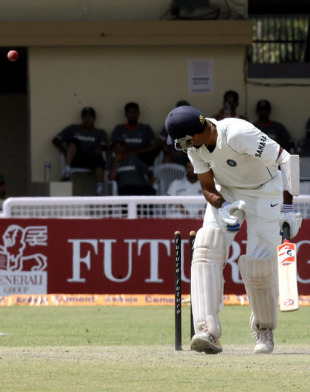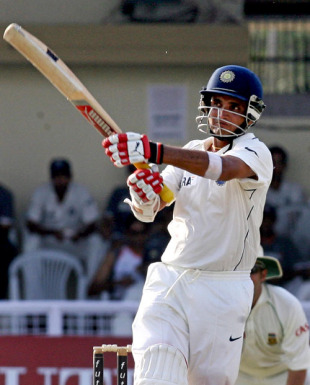Laxman and Ganguly master a meanie
Sourav Ganguly and VVS Laxman put India in a state from where they could have evened out the disadvantage of having to bat last
Sidharth Monga in Kanpur
12-Apr-2008

| ||
Bob Dylan could well have written this for the famed Indian batting after the first session in Ahmedabad: "And nobody has ever taught you how to live out on the street/ And now you find out you're gonna have to get used to it." If ever there was a mean street, the track at the Green Park was. Morne Morkel and Dale Steyn, bowling at high speed and getting variable bounce, were one Mean Street Posse, but two Indian batsmen did get used to living there all right.
Sourav Ganguly, who for one reason or another is always one failure short of a debate over his place in the Test side, and VVS Laxman, arguably India's best bad-pitch batsman, did that well enough to put India in a state from where they could have evened out the disadvantage of having to bat last. Then came a couple of irresponsible shots to let South Africa back into the match: a 23-run deficit with one wicket left shouldn't worry them much as of now.
The Indian batsmen as a unit - the pampered kids, the "masters of good surfaces" - worked hard for every single run, were prepared to drop and run, and were not lazy with their footwork. Such traits were very crucial on this track and yet India's batsmen managed to retain their elegance when they hit boundaries. But perhaps most importantly they put the shooters and spitters out their minds, even letting a few of them go for byes. They tried to score off every overpitched ball, knowing fully well that an unplayable delivery might come up anytime.
The beauty with bad pitches is that they usually bring out the best in Laxman. The little adjustments he makes, the way it seems he is batting on one pitch and his partner on another, is an education on how to bat on difficult surfaces. His shots remain beautiful to watch, and the changes he makes are so subtle that you don't even notice he has altered his approach. In his stance today, he crouched fractionally more than usual, negating the low bounce. His stance was a bit more open, making sure he didn't fall over when he came onto the front foot. That conscious effort to not fall over resulted in his only boundary that was not pretty - an outside edge off Morne Morkel early in his innings.
To Paul Harris his approach was quite unusual. Instead of playing the ball as late as possible, Laxman consistently kept coming forward, looking to play inside-out from the rough, something he has successfully done in the past against Shane Warne. That Steyn didn't show variations in pace meant Laxman could be sure of himself. The wrists ensured he kept the ball down even if it misbehaved.
But when Laxman did eventually get one that was too good, India were very much in trouble. That dismissal had followed the nasty delivery to Rahul Dravid, and at 123 for 4 India needed a special effort. That's when Ganguly played, as he said later, one of his best innings ever.
In the first over of spin he faced, Ganguly prodded half-heartedly at Paul Harris, was hit on the glove, and the ball lobbed to an empty space in the covers. He was so cross that he kicked the ground in disgust, turned around, regrouped, and went back to work. Of course he was beaten again, more than once, but those balls he couldn't have done anything about, and none of those deliveries upset his composure.

| ||
There was a definite plan to Ganguly's batting: an obvious one was trying to score off every opportunity, and also to not let Harris settle into any rhythm. Ganguly had perhaps recognised Harris as the least dangerous of the South African attack. The next ball after that prod was swept away, the first sweep shot of the innings. He kept stepping out to Harris on a regular basis, hitting him both with the spin, over midwicket, and against the turn through extra cover. The stepping out wasn't premeditated, as were the cases with Mahendra Singh Dhoni and Neil McKenzie when they were stumped.
What was even more remarkable was the urgency to take singles. This was a pitch on which every batsman needed to be a bit selfish and spend more time at the non-striker's end. Ganguly kept doing that with relative ease, running 53 out of his 87. With every run scored the bowlers kept feeling the kind of pressure that comes when you have been given a vicious track and are still not getting many wickets. They started trying too much, looking to bounce Ganguly out, and only served him with pull-me deliveries. Makhaya Ntini won't be forgetting in a hurry the pull Ganguly unleashed off his attempted bouncer.
On a track where survival was difficult, Ganguly managed to control the whole latter half of the Indian innings. When he got out, close to stumps, eight wickets had fallen and he knew he had to take complete charge and farm the strike. Ganguly compared this innings to his comeback knock at the Wanderers in December 2006, and said the conditions here perhaps made this one a better knock. However, there won't be a bigger tribute to this innings than to say he successfully took the bar one level higher than where Laxman had left it.
Sidharth Monga is a staff writer at Cricinfo